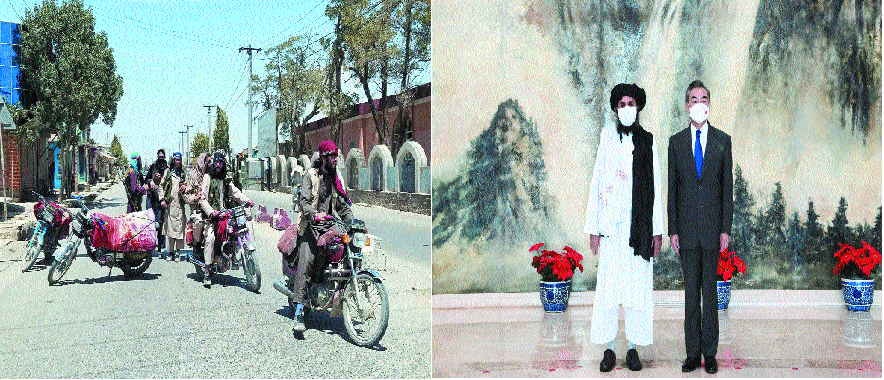Afghanistan: Whose baby will it be, anyway?
| Date :14-Aug-2021 |

By Rahul Dixit
Each time before entering the ring against a high-profile challenger, heavyweight boxing champion Mike Tyson would proclaim, “Everybody has a plan until they run into a punch in the mouth.” How the assertion holds true in the present situation in Afghanistan. As the conflict-torn country recoils in unabated violence unleashed by the Taliban militants, seeking absolute supremacy, all the lofty plans hammered out through an illusory truce process initiated at the behest of a home-sick United States have fizzled into a zilch. Afghanistan is clearly heading for an apocalypse. The moot question is; after the withdrawal of US and NATO troops, whose baby will it be, anyway?
The writing was on the wall for all to see when US hastened the peace talks by involving any comer who had resources to bring the Afghan Government and Taliban to the negotiating table. Russia, Pakistan, Qatar and even Turkey basked in the role of a facilitator eyeing a chunk of the soon-to-be-exposed Afghan pie. The troops withdrawal process that former US President Donald Trump started after his predecessor Barack Obama stalled it due to international image consciousness has been taken to a quick conclusion by current chief Joe Biden. Now, the ‘Graveyard of Empires’ is again ripe for a new regime. Who among the interested parties will call the last shot is a matter of great interest for the world.

Future contours of governance in Afghanistan will be decided in the next few weeks when last soldier of the foreign forces ends their two-decade occupation that started with a hunt for Al-Qaeda and inexplicably turned into rebuilding of Afghanistan. Not that the Afghans did not benefit from the presence of the troops, yet the fear of being left in the lurch always hovered over the provinces. As many as 13 of these provinces, including Kandahar and Ghazni in capital Kabul’s neighbourhood, have now fallen to the raging Taliban forces.
One thing that the US would never admit but had to endure silently was its consistent failure in many provinces like Helmand and Kunduz where Taliban never allowed the foreign forces a strong base. The Taliban’s capture of Kunduz in 2015 was a clear sign of resurgence of the militants in coming years. Latest Intelligence inputs have confirmed that the Taliban have joined forces with other militant groups in Afghanistan to seize military control of the country.
Afghanistan President Ashraf Ghani may like to project the fight of the Afghan National Forces in a positive manner, but the stark reality is that the country’s security forces just do not have the ability or resources to hold on to territories left vacant after withdrawal of US troops. A large number of Afghan troops have already surrendered to the Taliban.
It is clear that the Taliban were preparing for the day when the US forces would withdraw and they would go for the kill. There is simply no resistance to the violent march of the Taliban fighters. The Taliban blitzkrieg has scuttled every plan of a smooth transition in the country as envisaged by the United States. A complex geopolitical maze now operates in Afghanistan as actors like China, Russia and Pakistan target a position of strength in future Government. Interestingly, all of these countries have established direct channels with the Taliban, hinting at things to come.
China recently hosted a group of Taliban leaders and extracted promise of keeping the Xinjiang province, housing the Uyghur Muslims, safe from pro-Uyghur militant groups operating out of Afghan soil. Russia was among the ‘advisors’ for the Taliban while negotiating truce with US Special Representative Zalmay Khalilzad. Pakistan seeks to leverage the ISI influence on the Taliban to harm Indian interests in Afghanistan. All these are broad indicators of how things are going to pan out in Afghanistan even as India offers comfort to the Ashraf Ghani Government.
All these strategies, brought into play by the major players having deep interests in Afghanistan, stem from the belief that Taliban would be their trusted ally in the country. However, herein lies the big catch. For all its might and resources to take over Afghanistan, the Taliban still come up as a militant organisation built on the ideology of extremism. Shunning it completely for the sake of governance and maintaining international relations seems very difficult for the Taliban leadership.
Another potential development that is set to define the future course of the country is the differences in the old and new guard in Taliban. The new leadership is heavily tilted towards moderation but the old foxes, who once ruled the country, are still craving for their iron-handed, tyrannical and primitive rule.
The third and most dangerous possibility is the threat of an overambitious Taliban galvanising Islamist terrorism. If their ‘Islamic Emirate’ dream meets the dangerous idea of establishing ‘Caliphate’ peddled by the Islamic State of Iraq and Syria (ISIS), then the entire South Asian region will feel long-lasting repercussions. Intel has already warned about enduring ties between the Taliban and the Al-Qaeda despite vehement denial by the Taliban leadership. The current decisive shift in their military fortunes can easily change the Taliban’s posturing in the future.
Taliban in power is a dangerous prospect not only for Afghanistan but also for China and Pakistan. The current situation can have a direct impact on regional stability. China is extremely wary of the East Turkestan Islamic Movement which is a great sympathiser of the Uyghur Muslims in the Autonomous Xinjiang province. The very fact that China engaged the Taliban and extracted “friendship promise” reflects the worries that Beijing carries. Even if the Taliban stands by its commitment to keep the Xinjiang province out of terror ambit, the militants will surely extract costs from China.
Similarly, Taliban in power can easily have a reverse leverage on Pakistan. During the 1990s, Pakistan had opened spaces for the Taliban for its own geopolitical goals. However, that investment can easily backfire after the ascendancy Taliban has assumed through military power. A major section in Pakistan military establishment is extremely anxious about the Tehreek-i-Taliban Pakistan joining hands with Baloch groups to launch attacks in Pakistan.
For India, against the backdrop of this complex geopolitical picture, staying away from the current Afghan situation may look a good policy but the conflict is definitely not going to stay away from it. New Delhi has decided that it can engage only with an Afghan Government that has legitimacy. The way the regional actors including China, Russia, Pakistan and some Gulf States are working overtime to bring a cloak of legitimacy for their “good friend” Taliban, India might have to find a totally different dynamic to secure its current and future interests in Afghanistan.